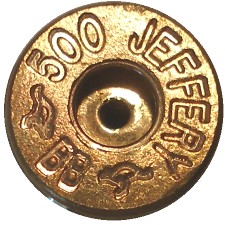 I don’t know why large dangerous game cartridges and rifles are described with an aura of mysticism. Objective data would seem more useful, but then I can’t even explain why I habitually put cheese on the top of my cheeseburgers and not on the bottom. Life can be quite a quandary. In covering the 500 Jeffery, I promised myself I would analyze only what insight comes through first hand observation and experience; shooting, handloading and data collecting and that I would avoid all of the usual drama and fantasy safari gibberish. I won’t be referencing Marlow perusing the Congo in search of Kurtz, the sound of distant drums or the face whipping experience of walking second in a line through tall grass. I won’t even suggest that I have discovered the existence of an alternative reality I had not previously considered.
I don’t know why large dangerous game cartridges and rifles are described with an aura of mysticism. Objective data would seem more useful, but then I can’t even explain why I habitually put cheese on the top of my cheeseburgers and not on the bottom. Life can be quite a quandary. In covering the 500 Jeffery, I promised myself I would analyze only what insight comes through first hand observation and experience; shooting, handloading and data collecting and that I would avoid all of the usual drama and fantasy safari gibberish. I won’t be referencing Marlow perusing the Congo in search of Kurtz, the sound of distant drums or the face whipping experience of walking second in a line through tall grass. I won’t even suggest that I have discovered the existence of an alternative reality I had not previously considered.
I will say, preliminarily, I am living in a world of oversize cartridges, oversize rifles and even oversize reloading presses and dies, without an elephant or cape buffalo in sight. My goal, as established before I began this project, was to load the 500 Jeffery to pressure levels more typical of today. My purpose is to call into question the capacity challenged and over-pressured 500 A-Square; aka the “.510/.460 Weatherby”, aka “.500 Jeffery Light” as its successor. The following is an overview that will be expanded in near future and subsequent parts of the series. Think of this as general project foundation for me to have fun and pretend I am writing for a purpose. Did I say that out loud? How about just then? Now?
The abridged history of the .500 Jeffery…according to me
 The 500 Jeffery made its original appearance in the mid 1920’s as the August Schüler Company’s 12,7 x 70mm Schuler. As with a number of cartridges of German origin being offered between WWI and WWII, the round was renamed by the British firearm firm Jeffery as the .500 Jeffery to make the chamber more palatable to British sportsmen. Sort of like Home Depot trying to remove the stigma of the metric Guatemalan plywood it sells by re-labeling it as 35/100″ in thickness.
The 500 Jeffery made its original appearance in the mid 1920’s as the August Schüler Company’s 12,7 x 70mm Schuler. As with a number of cartridges of German origin being offered between WWI and WWII, the round was renamed by the British firearm firm Jeffery as the .500 Jeffery to make the chamber more palatable to British sportsmen. Sort of like Home Depot trying to remove the stigma of the metric Guatemalan plywood it sells by re-labeling it as 35/100″ in thickness.
In Jeffery form, the cartridge pushed a 535 grain bullet, with 95 grains of Cordite, to 2,300 fps for nearly 6,286 ft/lbs of kinetic energy. In modern smokeless loading, slightly greater velocity is achieved with a heavier 570 grain bullet, bumping kinetic energy to near 7,000 ft/lb levels. The 500 Jeffery edges out the significantly larger capacity .505 Gibbs (.505 Rimless Magnum) in velocity and energy, while offering a broader selection of bullets for handloaders. This bit of velocity trickery is accomplished by loading the .500 Jeffery to a higher maximum average pressure. The 500 Jeffery operates in the 46,000 PSI range, the 505 Gibbs at 39,000 PSI. To put this in context, an even smaller .500 A-Square out performs both of these larger cartridges by upping its pressure ante to 64,000 PSI.
The .500 Jeffery does not have ANSI/SAAMI certification. Beginning in 1998 at, I believe, A-Square’s initiation, it was listed as of British origin and received C.I.P. “Commission Internationale Permanente” certification…apparently to appease Americans with low self-esteem who chronically seek the approval of Europeans. Regardless the formal standardization, the .500 Jeffery dimensions are well known and both factory ammo and firearms remain in active production. Until the advent of the 460 Weatherby Magnum, the .500 Jeffery was considered to be the most powerful production cartridge available. The 460 Weatherby claim is a little misleading as, like the 500 A-Square, the Weatherby is a smaller case operating at higher pressure.
Where’s Waldo?
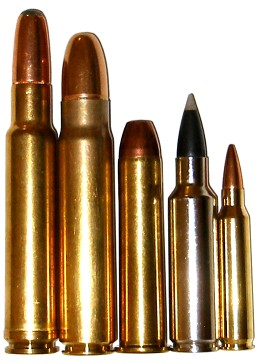
I apologize for stacking up so many cartridges, but I wanted to make sure there was something up there for everyone to relate to when putting the 500 Jeffery into cartridge size context. They are, left to right: .416 Weatherby, .500 Jeffery, .45-70, .325 WSM, .223 Remington. The first thing that came to mind when I started examining 500 Jeffery cases was how modern this 90 year old case design appeared.
Most modern cases have little body taper. The Jeffery case tapers 0.016″ from the case just above the extractor groove to the shoulder, or about 0.007″ of taper per inch. The 416 Weatherby, introduced in 1989, has 0.021″ of case taper, for 0.010″ of taper per inch. The 325 WSM, a line of cartridges thought to have very little case taper, comes in at 0.017″, or 0.011″ taper per inch. Even the 500 Jeffery’s slightly rebated rim is modern. It suggests reduced internal web planer surface area for reduced bolt thrust and allows a reduced bolt face diameter. While slightly shorter than the 416 Weatherby, it’s larger diameter provides 158 grains of capacity, compared to 135 grains for the relatively anemic Weatherby. This is fun.
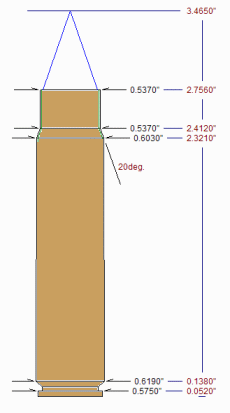
I am aware of two companies that produce and sell brass for the 500 Jeffery in the U.S., but one of them does so only occasionally. I was never able to locate a source for U.S. based Jamison brass as they appear to make the product to a known demand, rather than as speculative production. The retail outlets that sell their products had no stock of Jamison .500 Jeffery brass and none could offer an anticipated date of arrival. Bertram brass is a well known producer of brass for obsolete and more obscure cartridges. I was able to find Bertram made .500 Jeffery brass through several retailers and custom loaders. As an example, MidwayUSA carries 500 Jeffery brass priced at $109 for twenty pieces. While the cost of brass may seem high, I believe the cost and selection of loaded ammunition tends to make it appear to be a bargain.
|
Bertram Brass Comparison |
|||
| Dimension | Spec | Bertram* | Delta |
| COL | 3.4650 | N/A | N/A |
| Case Length | 2.7560 | 2.740 | -0.0160 |
| Shoulder Height | 2.4120 | 2.4300 | +0.0180 |
| Neck Diameter | 0.5370 | 0.5280 | -0.0090 |
| Shoulder diameter | 0.6030 | 0.5940 | -0.0090 |
| Rim Diameter | 0.5750 | 0.5730 | -0.0020 |
| Material Thickness | 0.0130 | 0.0150 | +0.0020 |
| *Unsized and unfired from factory. Chambered normally. | |||
Ten rounds from Superior Ammunition, CZ-USA‘s recommended .500 Jeffery ammunition suppler, are priced at approximately $165, KYNOCH-USA prices their .500 Jeffery ammo at $85/5 rounds. These prices also serve as insight into the science of price point setting; a company looks at competitor’s prices and makes their own the same. Norma lists the 500 Jeffery as a member of their African PH line, however, I was unable to locate Norma brand 500 Jeffery ammunition in the U.S., nor was I able to locate the country of Sweden on a world map. To which I can only say, Svenskar är inte vänliga.
Coincidentally, where you find big cases, you also find…
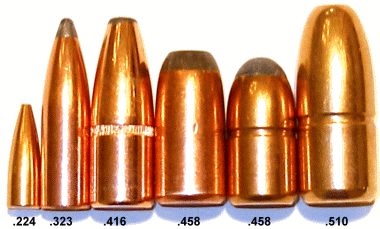
The .500 Jeffery takes a .510″ bullet, but not just any .510″ bullet. Those intended for the 50 BMG, 500 Nitro Express, .50 Alaskan or .50-110 cartridges differ in weight range, construction and/or location of cannelure. The 50 BMG bullets actually have a good deal of potential with the Jeffery, but the heavy weight makes for an overall length beyond the Mauser action’s capacity. Cast bullets, intended for the 50 Alaskan and .50-110, do bring the possibility of their use to the .500 Jeffery, with a weight range of 350 to 525 grains.
Large bullets make large holes that sever blood vessels and arteries and allow for rapid bleed out. I’ll go on the assumption this is a good alternative to becoming the squishy stuff between an elephant’s toes. Since hole size increases exponentially with an increase in radius, an move up from .416″ to .510″ caliber is significant in a hunting cartridge; a 51% larger hole size. Even an increase just from .458″ – .510″ is a 25% increase in hole size. The only thing that doesn’t seem priced in proportion to size in this project are bullets. In the case of the Jeffery, for a paltry $1 to $2 per bullet, a hunter can put a very large hole in a very large dangerous animal and still have enough money left over to pay the gang of armed professional hunters and trackers standing behind him.
Handloading equipment for the 500 Jeffery…broad strokes
 Handloading the .500 Jeffery isn’t overly difficult, but it requires a little planning. RCBS makes a three die set for the .500 Jeffery, which is one die more than typically supplied for a bottleneck cartridge. Rather than a part of the resizing operation, the expander step is accomplished with a separate die. This is a much cleaner way of setting inside neck diameter and this approach allows for slight flaring of the case mouth.
Handloading the .500 Jeffery isn’t overly difficult, but it requires a little planning. RCBS makes a three die set for the .500 Jeffery, which is one die more than typically supplied for a bottleneck cartridge. Rather than a part of the resizing operation, the expander step is accomplished with a separate die. This is a much cleaner way of setting inside neck diameter and this approach allows for slight flaring of the case mouth.
The dies are physically large; length and diameter. Where a typical die has 7/8″ threads, the .500 Jeffery set has 1″-14 threads. For handloaders, the .223 Remington cartridge may lend perspective.
This RCBS die set is special order, but it can be purchased through online retailers or local gun shops. RCBS offers the three die set I’ve noted, or any single die within that set. There is also a neck sizer version and a trim die for this cartridge. A customers may request a decapping rod with an expander ball as an alternative to the expander die. The price for this decapping rod and expander is $27. The typical cost of this Group X three die set is $449 and lead time is 90 days…which will give you time to save up the $449. I needed time to save up the $27.
 Big dies mean a big press, and they don’t get much bigger than the RCBS Ammo Master-2. With enough capacity to load the 50 BMG cartridge, the press will take up to 1½” dies, however, it is supplied with an adapter bushing to permit the use of standard 7/8″ dies. The .500 Jeffery die set has 1″-14 threads and is supplied with its own 1½”-12 to 1″-14″ adapter.
Big dies mean a big press, and they don’t get much bigger than the RCBS Ammo Master-2. With enough capacity to load the 50 BMG cartridge, the press will take up to 1½” dies, however, it is supplied with an adapter bushing to permit the use of standard 7/8″ dies. The .500 Jeffery die set has 1″-14 threads and is supplied with its own 1½”-12 to 1″-14″ adapter.
The significant differences between the Ammomaster-2 and a more standard reloading press are found in several key areas. The ram is 1½” compared to ¾” or 1″ on others. RCBS includes an adapter that permits the use of standard shell holders when the press is not set up to load the 50 BMG. The 500 Jeffery takes a #37 shell holder, the same as the the 416 Rigby. The space inside the frame, shell holder to top plate is 6″ compared to 3½ – 4″ with more standard size presses, the stroke is a full 5½” compared to a conventional press 3½”. Leverage at forming compression is approximately 18:1 for the RCBS unit and 7:1 for the standard set up. The MSRP for the AmmoMaster-2 is $321 but it can be found in the $264 range through most online discount retailers.
Big cars, fast cigars and the 500 Jeffery
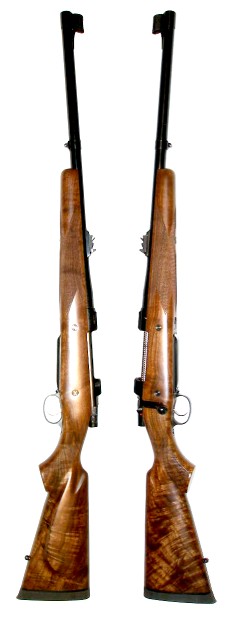 I have no doubt in my mind that the 500 Jeffery is effective for its intended purpose; bringing down the largest most dangerous game in the shortest possible time, but I can’t state with any certainty how many of these firearms are used for this purpose. I would suspect many of these guns are purchased, appreciated and, locked in a safe, then brought out for infrequent range excursions or as the object of firearm related conversation. The prior comment wasn’t a criticism. An appreciation for firearms comes in many forms, and an appreciation for a firearm’s potential represents a considerable percentage of firearm ownership. They are interesting, complicated machines.
I have no doubt in my mind that the 500 Jeffery is effective for its intended purpose; bringing down the largest most dangerous game in the shortest possible time, but I can’t state with any certainty how many of these firearms are used for this purpose. I would suspect many of these guns are purchased, appreciated and, locked in a safe, then brought out for infrequent range excursions or as the object of firearm related conversation. The prior comment wasn’t a criticism. An appreciation for firearms comes in many forms, and an appreciation for a firearm’s potential represents a considerable percentage of firearm ownership. They are interesting, complicated machines.
The 500 Jeffery, as is the case with similar cartridges, continually teeters on the brink of obsolescence. Whenever guns are built in multiples of ten rather than tens of thousands, and the cartridges they shoot are specifically for use on big and dangerous African game, the demand for rifles, ammunition and components is hardly sufficient to sustain mainstream commercial interest. Companies, however, that operate specialty and custom shops often know how to profitably service a small but well heeled market segment that wants this type of rifle.
Finding a rifle that is made for the .500 Jeffery is not always easy, at least not within reasonable cost constraints. Many are made and sold by by companies with long and pretentious names: Waffenfabrik Hein, B. Searcy & Company, W. J. Jeffery & Company, Westley Richards andPrechtl Firearms. You’d hardly assume the first company is a Washington state gun maker, or that the “B” in B. Searcy stands for Butch. When I put together a plain Jane 500 Jeffery using the Westley Richards site’s “Build a Gun” feature, the lowest price I could get to was $20,000. When I went back and “niced” it up, a just little bit, the price doubled. The rifle selected for this project is a CZ-USA’s SC 550 Safari Classic. The price as pictured is approximately $3,100 at retail prices. Nice gun.
An interesting part of the CZ-USA story and these Safari Classic rifles is that a significant part of their manufacturer is done in Kansas City, KS and not in the Czech Republic. The big square bridge 550 Magnum action used for the company’s 416 Rigby guns is produced by the parent company and shipped to their U.S. subsidiary. The rest of the rifle is built in the U.S. facility, right down to Missouri sourced American black walnut stocks, the fitting of barrels, finesse action work and wood and metal finishing. More on this later in the project.
Summary
| Project Component | Cost |
| CZ SC Safari Classic Rifle | $3,100 |
| RCBS Press and dies | 700 |
| 10 Rounds of ammo | 185 |
| Handload components | 200 |
| Total | $4,185 |
Considering the rifle’s price is substantially less than most of the competing products, I think there is some pretty good value here. The heavy duty, long stroke RCBS AmmoMaster was actually inexpensive compared to similar beefy presses and even some of the more standard products. The die set, compared to a standard two die rifle set probably seems high, but compared to limited run or customer dies I’ve gotten out of CH4D and Hornady, they are moderate in cost. Next up is handload development and detailed component selection. Now where can I find a lead sled?
The 500 Jeffery Project – Part I – When Way Too Much Is Just Enough
The 500 Jeffery Project Part II – Handloads and Range Results – Good Grief!
The CZ SC550 Safari Classic Part I
The CZ SC550 Safari Classic Part II

Email Notification